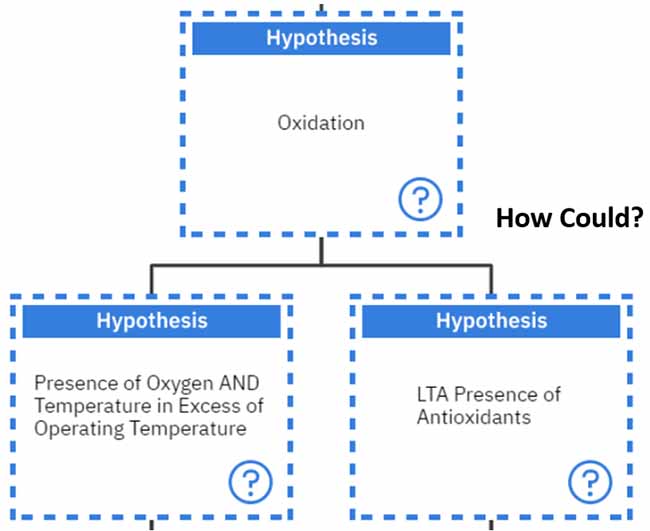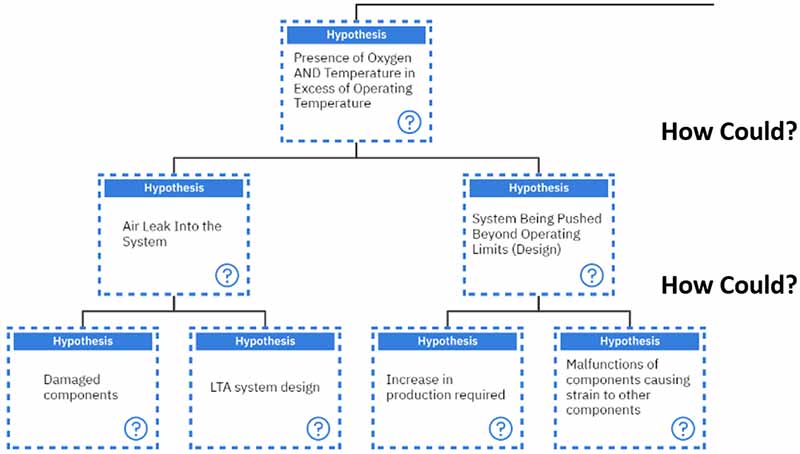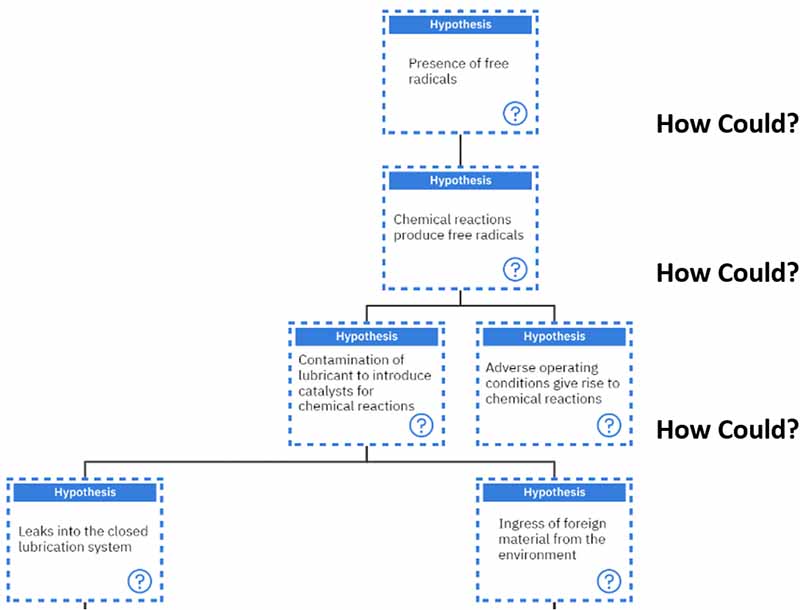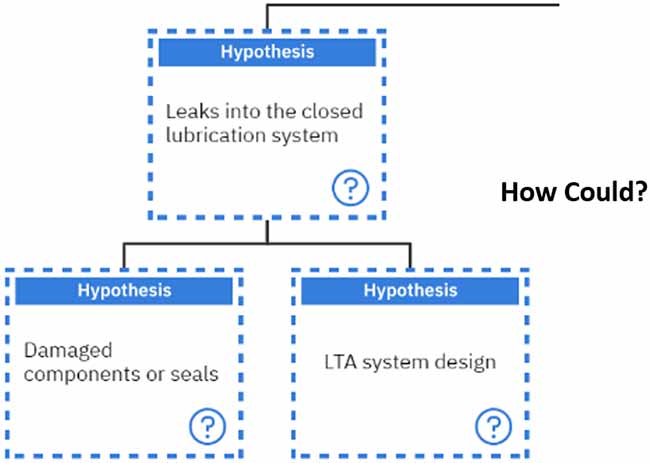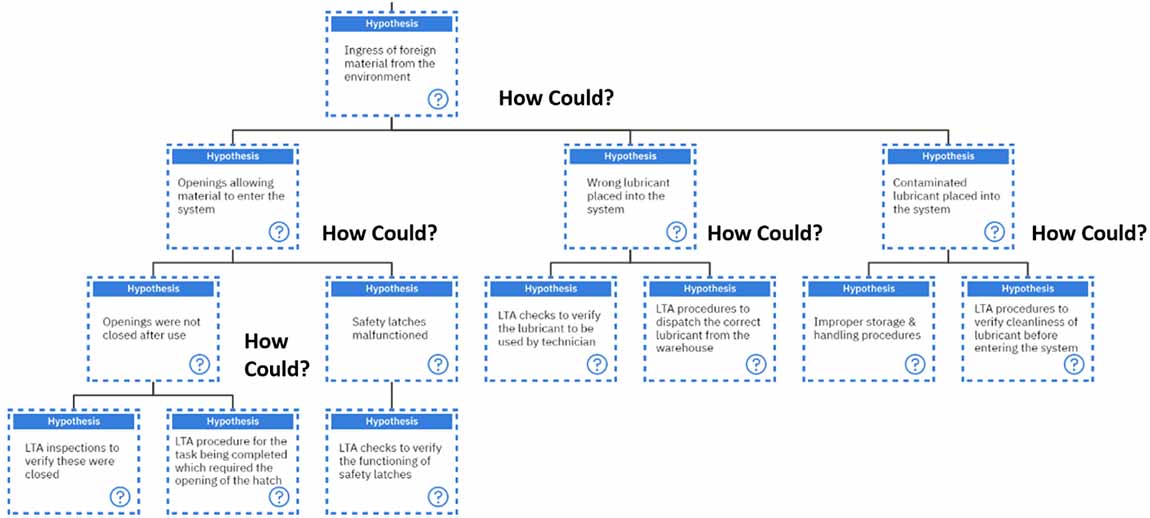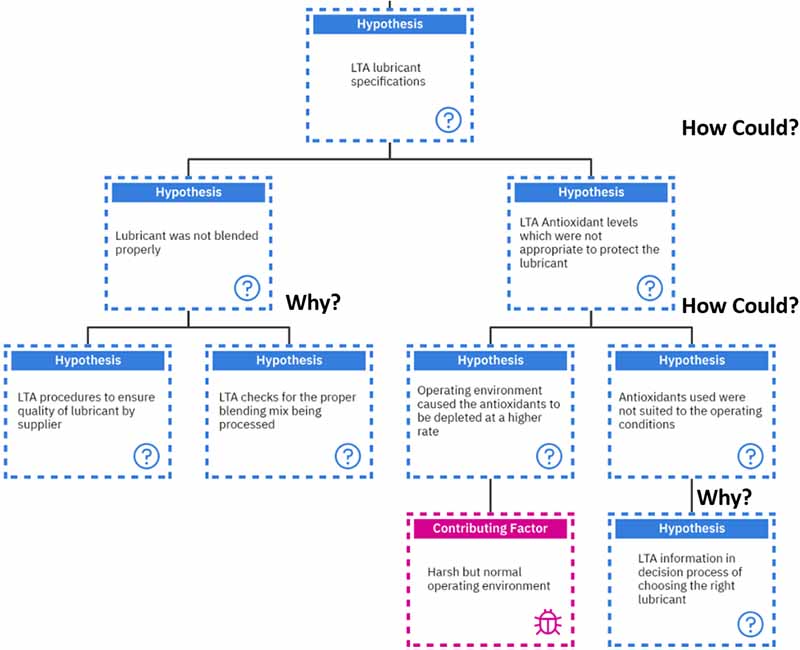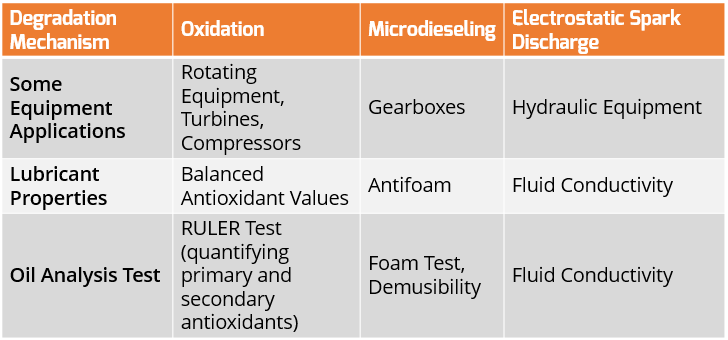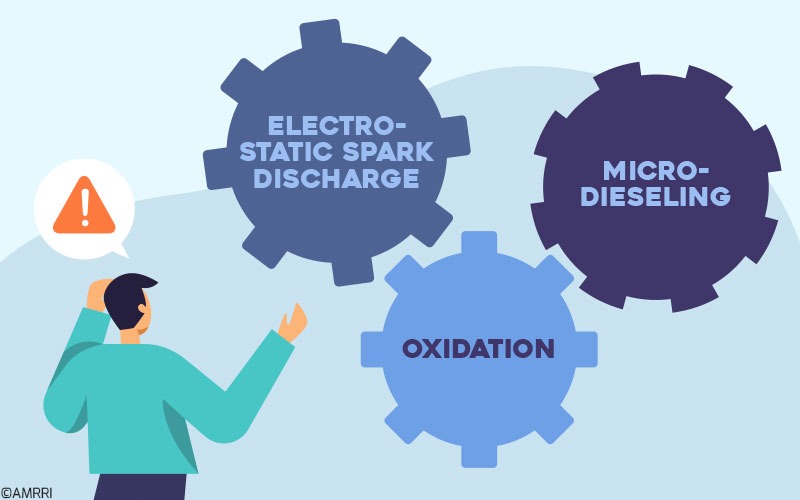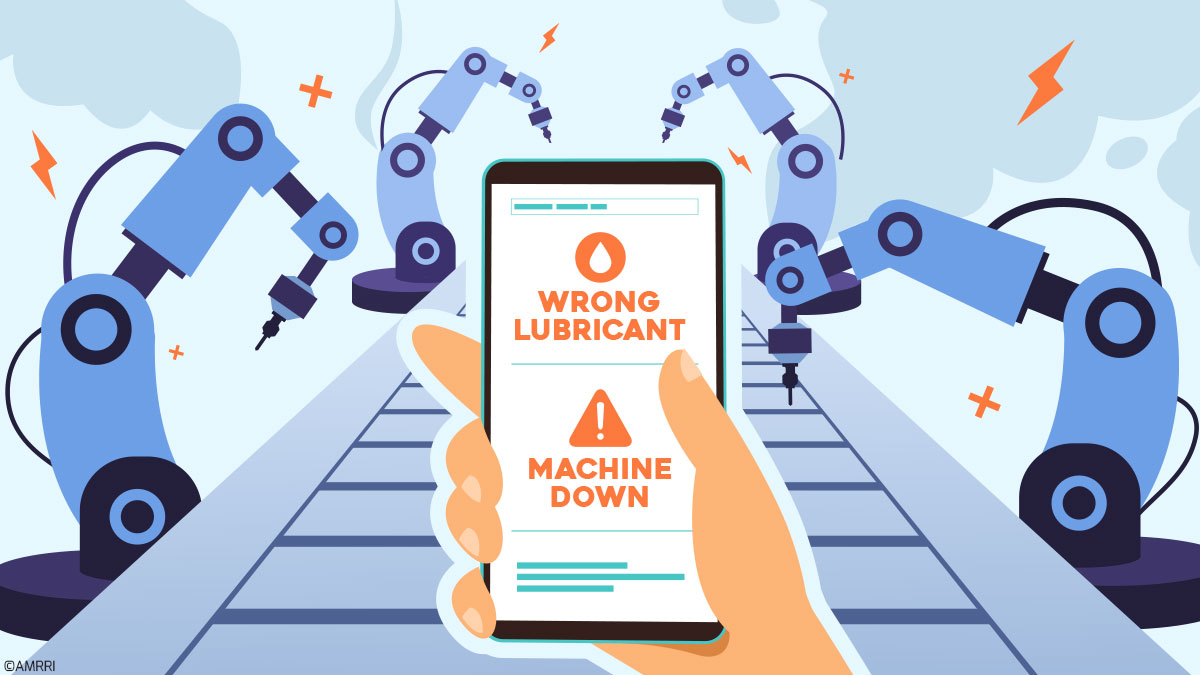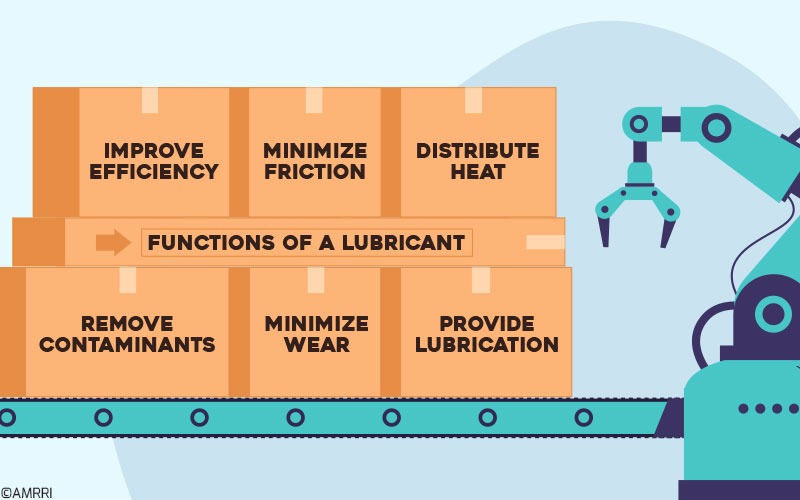Since we now have more information about the various types of antioxidants and how they function to suppress oxidation, the next step is to determine whether they are indeed present in our finished lubricants.
The industry tries to identify the presence of antioxidants in a couple of ways. The first way is to measure the rate of oxidation, which does not give the exact value of remaining antioxidants. Instead, it gives the user an idea of how much oxidation has taken place based on other lubricant characteristics.
Then, the user must make an informed decision on the remaining life of the oil. On the other hand, there is one direct test to determine which antioxidants are present in the oil and provide their remaining quantity.
Some common tests in the industry that measure the oxidation rate include RPVOT (Rotating Pressure Vessel Oxidation Test), Oxidation via FTIR, Viscosity, and TOST (Turbine Oil Oxidation Stability Test).
While none of these actually quantify the remaining antioxidants in the oil, they all provide the user with an indication of the rate of oxidation currently occurring in the oil. We will dive deeper into these to understand how they assess oxidation rates.
RPVOT
In the industry, RPVOT has been used for decades to provide users with an idea of the rate of oxidation occurring in their oils. However, this test is performed where the sample is placed in a sealed container with pressurized pure oxygen and rotated at a high speed in a bath with a higher temperature to promote the oil’s oxidation8.
As oxidation occurs, there is a pressure drop in the vessel, and the rate of this pressure drop is compared to that of new oil. The final result is given in minutes. Typically, if the value falls below 25% of the original value, the oil is on its way out or almost at the end of its remaining useful life.
But what happens if the value is at 75%? Since the final result is given in minutes, it isn’t easy to correlate that value to a value in the field.
For instance, if the RPVOT result was 800 minutes, we cannot easily correlate that to a particular number of years or months of life remaining for the oil. Hence, this method does not truly measure the remaining antioxidants in the oil.
Oxidation via FTIR
Another way of measuring oxidation is by identifying its presence through FTIR (Fourier Transform Infrared) Spectroscopy. In this type of test, each element produces a unique fingerprint.
As such, oxidation produces a particular peak between 1600-1800 cm-1. There is no absolute reference for oxidation peaks; therefore, these are usually compared against the new oil samples9.
This test (ASTM D 7414) is usually used for engine oils rather than industrial oils. However, it still does not provide the user with the remaining antioxidants in the oil. Instead, only that oxidation has already occurred.
Viscosity
In the past, viscosity was usually cited as a method for detecting if oxidation was occurring in the oil. However, due to more recent discoveries and technological evolution, we have noted that the oil’s viscosity only increases after oxidation has occurred.
Therefore, it is not a valid test to identify if oxidation is happening in the oil, as there can be several reasons for the increase in viscosity. In the case of oxidation, the presence of varnish and sludge would account for this increase; however, this test still doesn’t indicate the remaining antioxidants in the oil9.
TOST
This test, developed in 1943, evaluates the oil after it is subjected to very specific conditions. Typically, the oil is stressed with high temperatures (203°F / 95°C), gross contamination (17% water), and substantial air entrainment in the presence of iron and copper catalysts5.
The oil’s life is measured by the time the sample takes to achieve an Acid number of 2 mg KOH/g.
As such, this test measures the amount of acid produced by an oil under extreme conditions. Again, it does not give us a quantifiable correlation to the oil’s actual field life. It must also be noted that this test is not suited for hydraulic or gear oils but is more tailored to steam turbine oils, which may undergo those simulated conditions.
RULER® test
The RULER test utilizes linear sweep voltammetry to detect the quantity of antioxidants remaining in the oil. It produces a graph showing peaks at the detected antioxidants. Typically, the used oil results are compared against the baseline data to determine the quantity of antioxidants in the oil (Fluitec, 2022).
This method allows users to specifically quantify and trend the decline of antioxidants in the oil over a period of time, as seen in Figure 2. This is very valuable as users can now provide a better estimate of the remaining useful life based on the trend of the decline of antioxidants, and by extension, this helps them to understand the health of their oil.
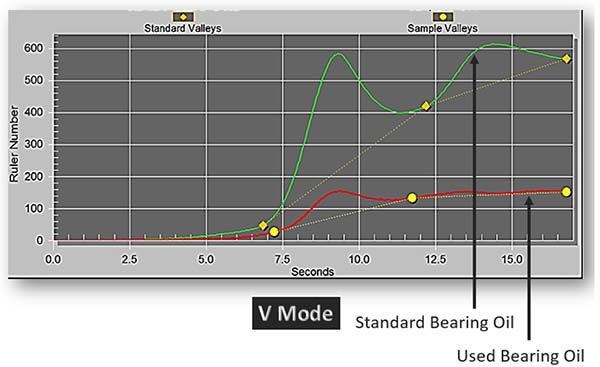
Oxidation occurs worldwide on almost every item (food, the human body, and lubricants). It is not going away anytime soon. Hence, there will always be a need for antioxidants to help protect the base oils for finished lubricants.
However, the formulations of these antioxidants may evolve over time as scientists find new, more sustainable alternatives for creating antioxidants.
OEMs also have a role to play as they advance machines and their capabilities; lubricants will have to be engineered for these new applications with varying environmental conditions. As such, there may be a greater need for more advanced antioxidants to help protect the oil.
References
- Bruce, R. (2012). Handbook of Lubrication and Tribology Volume II Theory and Design. Boca Raton: CRC Press.
- (2022, July 20). Why Choose RULER? Retrieved from Fluitec: https://www.fluitec.com/why-choose-ruler/
- Livingstone, G. (2024, February 15). Varnish Deposits in Bearings, Causes, Consequences and Cures. Retrieved from Precision Lubrication Magazine: https://precisionlubrication.com/articles/varnish-deposits-in-bearings-causes-consequences-and-cures/
- Mang, T., & Dresel, W. (2007). Lubricants and Lubrication. Weinheim: WILEY-VCH Verlag GmbH & Co. KGaA.
- (2016, April 17). Oil Oxidation Stability Test. Retrieved from Mobil: https://www.mobil.com/en/lubricants/for-businesses/industrial/lubricant-expertise/resources/oil-oxidation-stability-test
- Mortier, R. M., Fox, M. F., & Orszulik, S. T. (2010). Chemistry and Technology of Lubricants. Dordrecht: Springer.
- Pirro, D. M., Webster, M., & Daschner, E. (2016). Lubrication Fundamentals, Third Edition, Revised and Expanded. Boca Raton: CRC Press.
- (2024, March 06). Oxidation, the oil killer. Retrieved from SKF: https://www.skf.com/us/services/recondoil/knowledge-hub/recondoil-articles/oxidation-the-oil-killer
- Spectro Scientific. (2024, March 06). Measuring Oil Chemistry: Nitration, Oxidation, and Sulfation. Retrieved from Spectro Scientific: https://www.spectrosci.com/en/knowledge-center/test-parameters/measuring-oil-chemistry-nitration-oxidation-and-sulfation
- Stachowiak, G. W., & Batchelor, A. W. (2014). Engineering Tribology. Butterworth-Heinemann.





























